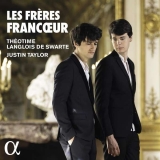Die musikalische Entwicklung vom Ende der Epoche von Ludwig XIV. bis zur beginnenden Romantik, also eine Zeit von etwa 120 Jahren, wird hier am Beispiel der Familie Francoeur in Noten erzählt. Viele Mitglieder dieser Familie waren herausragende Musiker ihrer Zeit, auf Instrumenten, aber auch als Orchesterleiter und als Lehrer. Doch auch die Verbindungen zu anderen Musikern gingen so weit, dass François Francoeur und François Rebel ihre Kompositionen zusammen schufen und der jeweilige Anteil am Entstehungsprozess nicht nachzuvollziehen ist.
Die eingespielten Werke zeichnen sich dadurch aus, dass sowohl der italienische (vor allem bei François Francoeur) wie auch der französische Stil (vor allem bei Louis Franceur), und ebenso der gemischte zu hören ist. Neben vollständigen Sonaten bzw. einer Suite haben Théotime Langlois de Swarte und Justin Taylor auch einzelne Sätze eingespielt, etwa auf die Besetzung angepasste Instrumentalsätze aus Opern. Die Werke wurden zwar auch immer wieder an den Zeitgeschmack angepasst, zeigen aber eher zurück als in die Zukunft. Ansonsten aber sind die stilistischen Ausrichtungen durchaus unterschiedlich.
Théotime Langlois de Swarte legt wiederum eine in höchstem Maße rhetorisch formulierte Auslegung seiner Sichten auf diese Werke dar. Einengungen oder Stolpersteine auf der technischen Seite scheint es für ihn ohnehin nicht zu geben. Deshalb gelingt es ihm immer wieder, voller Leben gestaltete Interpretationen zu erzielen, die die Musik genauso prägnant wie feingliedrig darlegen. Und schließlich zeigt er aufs Schönste, wie sich die verschiedenen Ausprägungen je nach Geschmack des Komponisten unterscheiden.
Mit Justin Taylor hat er sich einen Cembalisten an die Seite geholt, der diesen Weg der abwechslungsreichen und intensiven Deutungen ohne weiteres mitgehen kann und will. Dabei pflegen sie ein partnerschaftliches Musizierverhältnis, bei dem beide in bestem Einvernehmen zusammen wirken und sich gegenseitig sowohl die musikalischen Bälle zuwerfen wie auch sich aneinander
Abgerundet wird diese Aufnahme durch die famose Tontechnik, die das sehr präsente und trotzdem nicht die Nerven reizende Klangbild erzeugt sowie das kurz gefasst und dennoch informative Beiheft in drei Sprachen.
The musical development from the end of the era of Louis XIV to the beginning of the Romantic period, a period of about 120 years, is told here in notes using the example of the Francoeur family. Many members of this family were outstanding musicians of their time, on instruments, but also as orchestra leaders and as teachers. But also the connections to other musicians went so far that François Francoeur and François Rebel created their compositions together and the respective share in the creation process cannot be traced.
The recorded works are characterized by the fact that both the Italian style (especially with François Francoeur) and the French style (especially with Louis Franceur), and also the mixed style can be heard. In addition to complete sonatas or a suite, Théotime Langlois de Swarte and Justin Taylor also recorded individual movements, such as instrumental movements from operas adapted to their instruments. The works were also repeatedly adapted to the taste of the time, but point back rather than into the future. Otherwise, however, the stylistic orientations are quite different.
In Justin Taylor he has found a harpsichordist who is able and willing to follow this path of varied and intense interpretations. They cultivate a musical partnership in which both work together in perfect harmony, throwing the musical balls to each other as well as playing off each other.
This recording is rounded off by the splendid sound engineering, which creates the very present sound image that nevertheless does not irritate the nerves, as well as the concise yet informative booklet in three languages.
























